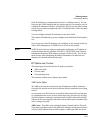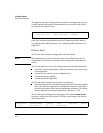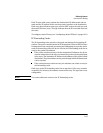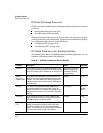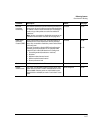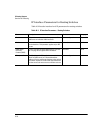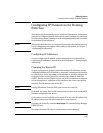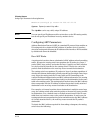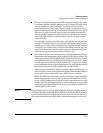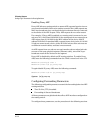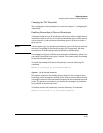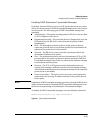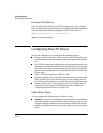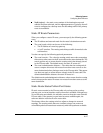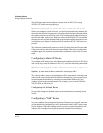
IP Routing Features
Configuring IP Parameters for Routing Switches
First, the routing switch looks in the ARP cache (not the static ARP table)
for an entry that lists the MAC address for the IP address. The ARP cache
maps IP addresses to MAC addresses. The cache also lists the port
attached to the device and, if the entry is dynamic, the age of the entry. A
dynamic ARP entry enters the cache when the routing switch receives an
ARP reply or receives an ARP request (which contains the sender’s IP
address and MAC address). A static entry enters the ARP cache from the
static ARP table (which is a separate table) when the interface for the
entry comes up.
To ensure the accuracy of the ARP cache, each dynamic entry has its own
age timer. The timer is reset to zero each time the routing switch receives
an ARP reply or ARP request containing the IP address and MAC address
of the entry. If a dynamic entry reaches its maximum allowable age, the
entry times out and the software removes the entry from the table. Static
entries do not age out and can be removed only by you.
If the ARP cache does not contain an entry for the destination IP address,
the routing switch broadcasts an ARP request out all its IP interfaces. The
ARP request contains the IP address of the destination. If the device with
the IP address is directly attached to the routing switch, the device sends
an ARP response containing its MAC address. The response is a unicast
packet addressed directly to the routing switch. The routing switch places
the information from the ARP response into the ARP cache.
ARP requests contain the IP address and MAC address of the sender, so
all devices that receive the request learn the MAC address and IP address
of the sender and can update their own ARP caches accordingly.
Note: The ARP request broadcast is a MAC broadcast, which means the
broadcast goes only to devices that are directly attached to the routing
switch. A MAC broadcast is not routed to other networks. However, some
routers, including HP routing switches, can be configured to reply to ARP
requests from one network on behalf of devices on another network. See
“Enabling Proxy ARP” below.
Not e If the routing switch receives an ARP request packet that it is unable to deliver
to the final destination because of the ARP time-out and no ARP response is
received (the routing switch knows of no route to the destination address),
the routing switch sends an ICMP Host Unreachable message to the source.
16-11



